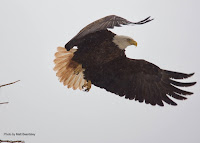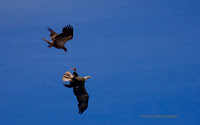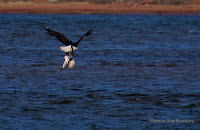BALD EAGLE
BALD EAGLE ( Haliaeetus leucocephalus) – (See images below)
DESCRIPTION: The Bald Eagle is a seabird with brown plumage except for the head, which is white. The tail also is white. The yellow bill ends with a hook on the upper mandible. The eyes are yellow. The legs are covered in feathers, and the feet are yellow with powerful brown talons. Sexes are similar but females are larger, as is the case for many raptors. Juveniles are brown with some white on the wings. It takes them four years to reach adult plumage. The bald eagle is one of the larger eagles with a wing span of around 2 meters (6.5 feet) and a length of about one meter (39 inches).
VOICE: https://www.xeno-canto.org/species/Haliaeetus-leucocephalus – Surprisingly for a bird that large, its calls are rather weak.
NAME: The English name ‘Eagle’ comes from French ‘Aigle’ and Latin ‘Aguila’, which means ‘eagle’. The bald eagle is not ‘bald’, but white-headed. The term ‘bald’ originates from an old meaning for a white head. The Latin genus name ‘Haliaeetus’ is from Greek and means ‘Osprey’ or ‘sea eagle’. As for the Latin species name ‘leucocephalus’, it means ‘white head’.
HABITAT: Near water with plenty of fish, also in mountain and open areas.
DIET: Mostly fish; birds and mammals, some carrion. Also steal prey from the smaller Osprey. See photo below of an adult going even further by attacking the Osprey itself.
In British Columbia each year there is a gathering of large numbers of bald eagles feasting on salmon.
NESTING: The bald eagle is known to build the largest nest structure in a tree. The nest becomes large because it is used year after year, and the eagles add new material to it each year. Sometimes the nest becomes so heavy that it collapses. About two white eggs are laid, which are incubated by both parents. They also both feed the young. Here’s an article about a young rescued after falling off its nest during a storm.
DISTRIBUTION: The breeding range of the bald eagle covers most of Canada and Alaska up to the tree line. It is a year-round resident along the western coast of Alaska, British-Columbia and the northwest states of the USA, as well as the Canadian Maritimes and the Great Lakes area. In the winter it is also found in the remaining USA.
DISTRIBUTION MAP: https://en.wikipedia.org/wiki/Bald_eagle#/media/File:Distribution_H._leucocephalus.png
ON PEI: The bald eagle is a year-round resident on Prince Edward Island. and is fairly common.
CONSERVATION: Once close to extinction, bald eagle numbers have made a successful comeback, notably following the ban on DDT, and legal protection from hunting. Although adults are considered apex predators, their eggs and chicks are vulnerable. Sometimes an adult can be caught in fishing gear, such as in this instance here. Bald eagles need large and healthy trees for their huge nests.
NOTES: The bald eagle is the National Bird of the United States.
Osprey attack: The last photo below shows an adult bald eagle attacking an osprey that was hunting for fish. The osprey desperately tries to fly off the water before the eagle swoops down on it. The eagle made more than one pass, eventually was able to catch the osprey and carried it away for a short distance before dropping it off in the end. Will that osprey survive the injuries from the eagle’s talons?
SIMILAR SPECIES: Golden Eagle, Turkey Vulture
REFERENCES: https://www.audubon.org/field-guide/bird/bald-eagle
http://www.hww.ca/en/wildlife/birds/bald-eagle.html
https://www.canadiangeographic.ca/article/animal-facts-bald-eagle
https://www.borealbirds.org/bird/bald-eagle
https://www.mba-aom.ca/jsp/toc.jsp (Maritimes Breeding Bird Atlas)
http://www.nhptv.org/natureworks/baldeagle.htm (New Hampshire PBS)
https://www.biologicaldiversity.org/species/birds/bald_eagle/index.html
https://hawkwatch.org/learn/factsheets/item/363-bald-eagle
https://www.allaboutbirds.org/guide/bald_eagle/id
https://en.wikipedia.org/wiki/Bald_eagle
https://nature.mdc.mo.gov/discover-nature/field-guide/bald-eagle (Missouri Department of Conservation)
DESCRIPTION: The Bald Eagle is a seabird with brown plumage except for the head, which is white. The tail also is white. The yellow bill ends with a hook on the upper mandible. The eyes are yellow. The legs are covered in feathers, and the feet are yellow with powerful brown talons. Sexes are similar but females are larger, as is the case for many raptors. Juveniles are brown with some white on the wings. It takes them four years to reach adult plumage. The bald eagle is one of the larger eagles with a wing span of around 2 meters (6.5 feet) and a length of about one meter (39 inches).
VOICE: https://www.xeno-canto.org/species/Haliaeetus-leucocephalus – Surprisingly for a bird that large, its calls are rather weak.
NAME: The English name ‘Eagle’ comes from French ‘Aigle’ and Latin ‘Aguila’, which means ‘eagle’. The bald eagle is not ‘bald’, but white-headed. The term ‘bald’ originates from an old meaning for a white head. The Latin genus name ‘Haliaeetus’ is from Greek and means ‘Osprey’ or ‘sea eagle’. As for the Latin species name ‘leucocephalus’, it means ‘white head’.
HABITAT: Near water with plenty of fish, also in mountain and open areas.
DIET: Mostly fish; birds and mammals, some carrion. Also steal prey from the smaller Osprey. See photo below of an adult going even further by attacking the Osprey itself.
In British Columbia each year there is a gathering of large numbers of bald eagles feasting on salmon.
NESTING: The bald eagle is known to build the largest nest structure in a tree. The nest becomes large because it is used year after year, and the eagles add new material to it each year. Sometimes the nest becomes so heavy that it collapses. About two white eggs are laid, which are incubated by both parents. They also both feed the young. Here’s an article about a young rescued after falling off its nest during a storm.
DISTRIBUTION: The breeding range of the bald eagle covers most of Canada and Alaska up to the tree line. It is a year-round resident along the western coast of Alaska, British-Columbia and the northwest states of the USA, as well as the Canadian Maritimes and the Great Lakes area. In the winter it is also found in the remaining USA.
DISTRIBUTION MAP: https://en.wikipedia.org/wiki/Bald_eagle#/media/File:Distribution_H._leucocephalus.png
ON PEI: The bald eagle is a year-round resident on Prince Edward Island. and is fairly common.
CONSERVATION: Once close to extinction, bald eagle numbers have made a successful comeback, notably following the ban on DDT, and legal protection from hunting. Although adults are considered apex predators, their eggs and chicks are vulnerable. Sometimes an adult can be caught in fishing gear, such as in this instance here. Bald eagles need large and healthy trees for their huge nests.
NOTES: The bald eagle is the National Bird of the United States.
Osprey attack: The last photo below shows an adult bald eagle attacking an osprey that was hunting for fish. The osprey desperately tries to fly off the water before the eagle swoops down on it. The eagle made more than one pass, eventually was able to catch the osprey and carried it away for a short distance before dropping it off in the end. Will that osprey survive the injuries from the eagle’s talons?
SIMILAR SPECIES: Golden Eagle, Turkey Vulture
REFERENCES: https://www.audubon.org/field-guide/bird/bald-eagle
http://www.hww.ca/en/wildlife/birds/bald-eagle.html
https://www.canadiangeographic.ca/article/animal-facts-bald-eagle
https://www.borealbirds.org/bird/bald-eagle
https://www.mba-aom.ca/jsp/toc.jsp (Maritimes Breeding Bird Atlas)
http://www.nhptv.org/natureworks/baldeagle.htm (New Hampshire PBS)
https://www.biologicaldiversity.org/species/birds/bald_eagle/index.html
https://hawkwatch.org/learn/factsheets/item/363-bald-eagle
https://www.allaboutbirds.org/guide/bald_eagle/id
https://en.wikipedia.org/wiki/Bald_eagle
https://nature.mdc.mo.gov/discover-nature/field-guide/bald-eagle (Missouri Department of Conservation)
 |
| Bald eagle adult, PEI, Matt Beardsley |
 |
| Bald eagle pair, PEI, Matt Beardsley |
 |
| Bald eagle in flight, PEI, Matt Beardsley |
 |
| Bald eagle juveniles at play, PEI by Matt Beardsley |
 |
| Bald eagle flying away from photographer PEI, by Matt Beardsley |
 |
| Bald eagle juvenile, PEI, Matt Beardsley |
 |
| Juvenile Bald eagles doing aerials PEI, by Matt Beardsley |
 |
| American crow 'buzzing the tower' |
 |
| Bald eagle juvenile sparring with an adult, PEI, by Isobel Fitzpatrick |
 |
| Bald eagle immature chasing a Herring gull away, PEI, by Matt Beardsley |
 |
| Bald eagle trying to regurgitate something PEI, by Don McLelland |
 |
| Bald eagle juvenile in flight PEI, by Marie Smith |
 |
| Bald eagle going after a scaup PEI, by Don McLelland |
 |
| Bald eagle adult caught Osprey |